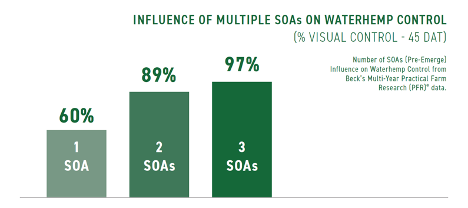If I were to ask the question, “What are the two largest management factors that come to mind when you hear soybean management factors?” What would your answer be? For myself, the top two things that come to mind are early planting date (late March and April) and herbicide resistance.
Early planting date has arguably been the biggest soybean yield driver because of the increased number of days before the plant starts to flower. This allows the soybean plant to produce more nodes and branches, which can lead to more flowers that potentially result in more pods per plant and bushels per acre.
However, just like anything in agriculture, there will always be caveats. The largest caveat for early planted soybeans is cool and wet weather. If we go back to early April in both 2020 and 2021 in southern Illinois, conditions were excellent in the first half of April, which resulted in many corn and soybean acres being planted. However, the tables quickly turned as some very cool and wet conditions arrived in late April and early May. This brought about numerous issues – from insect damage and disease to frost damage and herbicide injury, which in some cases resulted in an ugly thing called, replant.
Cool and wet weather were the largest drivers in these delayed emerging or replant scenarios, but an influence that can have a large effect is the use of a pre-emergent herbicide. Again, herbicide resistance is one of the top two things that I think about when I think about soybean management factors. One of the best ways to help overcome herbicide resistance is the use of a pre-emergent herbicide that contains multiple effective Sites of Action (SOAs) to never allow the weeds to emerge.
In 2020, Beck’s Hybrids PFR program conducted a study that demonstrated a 29% increase in waterhemp control moving from one to two effective SOAs, and a 37% increase in waterhemp control when moving from one to three effective SOAs.
As demonstrated in Figure 1, three effective SOAs resulted in 97% control on waterhemp 45 days after the treatment was applied. So, what is the caveat you may ask? The caveat is that the three effective SOAs included a group 5, 14, and 15 herbicide. Group 14 herbicides can be detrimental to soybean emergence in cool and wet conditions because they struggle to metabolize that particular herbicide.

Sometimes group 5 herbicides, like metribuzin, can cause similar effects. The data shows that these herbicides can be very effective for waterhemp control, however, we need to be mindful of other tools that we may have in our toolbox. For example, Xtend and Xtendflex soybeans have come into the market in recent years, but the largest knock with these trait platforms are volatility issues when using the Dicamba herbicide. However, when this technology was released, the main emphasis was put on the post-emergence application and not soil-applied or pre-emergent applications. Dicamba has proven to have some soil/residual activity. In addition, the soybean plant will be tolerant to this chemistry and should not delay soybean emergence like a Group 14 herbicide in cool and wet conditions. In the end, the dicamba herbicide in a pre-emergent scenario will be safe for the emerging soybean plants while also providing burndown and residual activity.
As we move further into the month of April and look to get a crop planted, we need to be cognizant of not only planting conditions, but also the extended forecast. I recommend that if there are multiple days in the forecast that will not rise about 60-degrees Fahrenheit, pull those group 14, PPO, herbicides out of the pre-emergent application. Never hesitate to look at other tools in the toolbox because a well-balanced weed management system is the best system!






 and then
and then